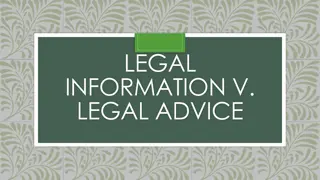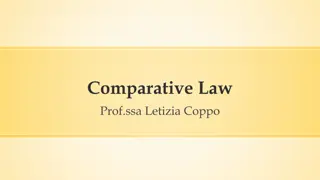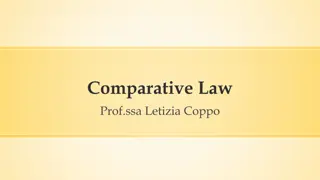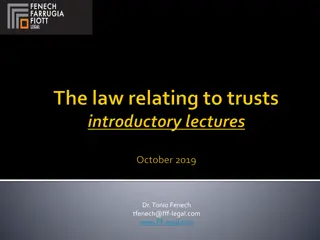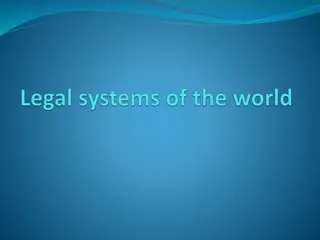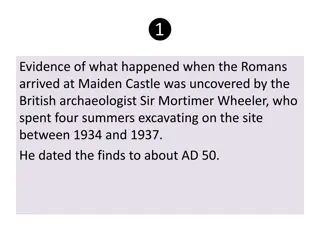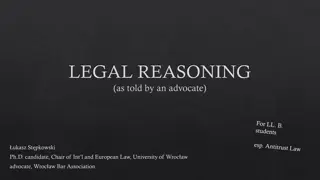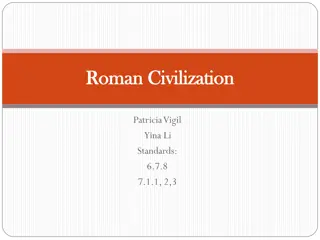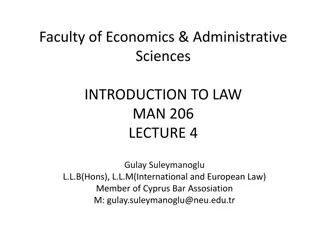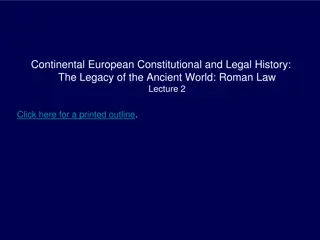Overview of Legal Systems and Roman Law Development
Legal systems play a crucial role in governing societies, with Roman Law, Common Law, Civil Law, and Religious Law being some of the major types worldwide. Roman Law, focusing on private law, has influenced legal traditions in various regions, especially in Europe. Contrasting Common Law and Civil Law systems highlight differences in constitution, judicial decisions, and roles of lawyers and judges. Understanding these legal systems provides insight into the foundations of modern law practices.
Download Presentation

Please find below an Image/Link to download the presentation.
The content on the website is provided AS IS for your information and personal use only. It may not be sold, licensed, or shared on other websites without obtaining consent from the author.If you encounter any issues during the download, it is possible that the publisher has removed the file from their server.
You are allowed to download the files provided on this website for personal or commercial use, subject to the condition that they are used lawfully. All files are the property of their respective owners.
The content on the website is provided AS IS for your information and personal use only. It may not be sold, licensed, or shared on other websites without obtaining consent from the author.
E N D
Presentation Transcript
Faculty of Economics & Administrative Sciences INTRODUCTION TO LAW MAN 206 LECTURE 2 Gulay Suleymanoglu L.L.B(Hons), L.L.M(International and European Law) Member of Cyprus Bar Assosiation M: gulay.suleymanoglu@neu.edu.tr
Legal Systems of the World There are hundreds of legal systems in the world. Roman Law Common Law Civil Law Religious Law
The structure, character and content of Roman law Roman law is first and foremost private law, law of and between citizens. In relation to it public law and the law of nations are less important. Roman law is concerned with the relationships between people, their legal actions, and the right they have on goods. The main characteristics of Roman law are as follows; (1) The law is divided into public and private (2) Legal rules are in the form of written law, codes and regulations. This means that custom and court decisions have only a limited role as a source of law. European systems of law( except England) and all of the central and South American, the Philippines, Japan, Turkey, Italy have based their laws on the Roman law traditions.
Summary of Differences between Civil law and Common law legal systems Feature Common Law Civil Law Written constitution Not always Always Judicial decisions Binding Not binding Roles of a Lawyer and Judge in Each System In civil law countries, judges are often described as investigators. They generally proceedings by bringing charges, establishing facts through witness examination and applying remedies found in legal codes. Lawyers still represent the interests of their clients in civil proceedings, but have a less central role take the lead in the
Roles of a Lawyer and Judge in Each System In contrast, in a common law country, lawyers make presentations to the judge (and sometimes the jury) and examine witnesses themselves. The proceedings are then refereed by the judge, who has somewhat greater flexibility than in a civil law system to fashion an appropriate remedy at the conclusion of the case. In these cases, lawyers stand before the court and attempt to persuade others on points of law and fact, and maintain a very active role in legal proceedings.
Roman Law Roman law is the legal system of ancient Rome, including Roman Military Jurisdiction and the legal developments spanning over a thousand years of jurisprudence. This was the system of law developed and applied by ancient Rome, and the Roman Empire. As a legal system, Roman law has affected the development of law in most of Western civilization as well as in parts of the East. It forms the basis for the law codes of most countries of continental Europe and derivative systems elsewhere. The term Roman law today often refers to more than the laws of Roman society. The legal institutions evolved by the Romans had influence on the laws of other peoples in times long after the disappearance of the Roman Empire and in countries that were never subject to Roman rule.
Sources of Law Where do we search to find answers to legal questions? What are sources of law upon which a judge and lawyer may base his decisions or arguments? As a general rule, the first source is written set of laws, rules or regulations and the judicial decisions. Every system of law has its own sources determined by its constitutions and traditions.
Sources of Law Every system of law has its own sources determined by its constitutions and traditions There are many different sources of law: Constitution Customary law Common law Case law International Treaties Regulations Statutes
Constitution A constitution is a set of fundamental principles or established precedents according to which a state or other organization is governed. These rules together make up, i.e. constitute, what the entity is. When these principles are written down into a single document or set of legal documents, those documents may be said to embody a written constitution; if they are written down in a single comprehensive document, a codified constitution. In any country with a written Constitution, the Constitution will take precedence over any other source of law. For example, if the Constitution says there is freedom of speech for all citizens, but the social tradition is for women not to speak in public, a court will protect the right of any woman to speak in public if she chooses to do so; the Constitution takes priority over tradition. it is said to embody
Customary Law Customary law is by definition unwritten law. Customary law had particular importance as being obligatory and binding by general public. Traditional common rule or practice that has become an intrinsic part of the accepted and expected conduct in a community, profession, or trade and is treated as a legal requirement. In developing countries which have been decolonized since the 1940s or 1950s, the law is generally a mixture of law introduced by the former colonial power and customary law which was there before colonization. That customary law often still takes priority in certain areas of life. Typically, customary law applies in those areas of life least affected by colonization. These may include land ownership, customary titles and family relationships. There may be special courts to deal with these matters, conducted according to tradition and presided over by a customary chief or group of elders. Alternatively, these matters may be dealt with by an ordinary court, but customary law may take precedence over other kinds of law in these cases.
Common Law English common law is the customary law of England, yet it has become influential in the laws of many other countries. The United States and most countries in the Commonwealth have legal systems based on English common law. If there is nothing in the Constitution to cover a situation, and if no specific law has been passed by parliament to cover a situation, a court in a Commonwealth country may decide the case depending upon English common law. Indeed, some Commonwealth countries have the British House of Lords as their final court of appeal.
Case Law Legislatures pass laws, but courts work out what they mean in practice. Laws are interpreted and tested by a succession of trials, over a period of time, under a variety of circumstances. For example, the law says in some countries that cars should drive on the left-hand side of the road; but it also says that boats should pass port-to- port (that is, as if they were on the right-hand side of an imaginary road). What should happen in the event of a flood, where a truck driving along a flooded road meets a boat coming the other way? Is the road still a road? If so, they must keep left and pass right-side to right-side. Or is it now a waterway? If so, they must keep right and pass left-side to left-side. The legislation will state clearly what the rules are in each case; but it is unlikely to say clearly how deep the water has to be before a road turns into a waterway. Courts often have to decide such things. An important part of legal training is to learn what judgments have been made in the past, in order to know exactly what each law means. This is called case law, and lawyers will quote previous cases in court, in order to show how the law should be applied in this case.
International Treaties As for the place of international treaties in the hierarchy of sources of law, domestic laws may differ considerably. Each country has its own particularities as regards ratification or publication of international treaties. Treaties can be referred to by a number of different names: international conventions, covenants, final acts, charters, protocols, and constitutions for international organizations. Usually these different names have no legal significance in international law Treaties may be bilateral (two parties) or multilateral (between several parties) and a treaty is usually only binding on the parties to the agreement. international agreements,
Regulation Although many people use the terms "statute" and "regulation" interchangeably, they aren't the same. Regulations are rules and administrative codes issued by governmental agencies at all levels, municipal, county, state and federal. Although they are not laws, regulations have the force of law, since they are adopted under authority granted by statutes, and often include penalties for violations. The regulation-making process involves hearings, publication in governmental journals which supposedly give public notice, and adoption by the agency.
Statute A statute is a formal written enactment of a legislative authority that governs a state, city or country. Typically, statutes command or prohibit something, or declare policy. Statutes are laws made by legislative bodies and distinguished from case law and regulations issued by government agencies. Statutes are sometimes referred to as legislation. As a source of law, statutes are considered primary authority. Ideally all statutes must be in harmony with constitutional law or the fundamental law of the land. Before a statute becomes law in some countries, it must be agreed upon by the highest executive in the government, and finally published as part of a code. which is decided by courts,
The development of English Law The history of English land law can be traced into Roman times. Roman law influenced the development of the law in many countries including most of Europe. In England this did not happen. In England beginning with local custom and drawing from many sources. The English common law developed and forms the basis of the law of many countries like USA, Australia and India. English Common Law underpins the law in many jurisdictions which in turn have contributed to the evolution of the common law. The common law has developed through judicial decisions in cases that articulate principles and rules, but one must bear in mind the important role that Parliament plays in enacting statutory laws. .Indeed, in UK common law Parliament is seen as the sovereign law making power.
Customs The basic law of Britain (except Scotland) is English common law, an unwritten law based on custom. Customs which means set of traditions which grow over period. In primitive society the first courts are set up and will to some extent, make law although such courts will tend to be declaratory. This means they will state the law and will choose between custom, they will enforce or not and they will choose between conflicting customs. In order to show that customary law exists, now, one has to apply certain tests, for example: one of the important tests is that custom has existed for a long time, this means that one looks at legal memory which England begins at 1189 A.D and the customs must have existed since that date.
How to read a court case As you read the case, answer the following questions: 1. Begin with the name and citation of the case. 2. Is this case being decided by a trial court or an appellate court? 3. In the original case, who was the plaintiff and who was the defendant? 4. What was the original complaint? 5. What were the facts that led to the complaint? 6. What was the trial court's decision? (who "won" the case) 7. What are the legal questions/issues that are being raised on appeal? 8. What is the present court's decision (is the original decision affirmed, reversed, or remanded?) 9. What rule or test is the court using to decide the outcome? This will relate to the legal question that must be decided. 10. What reason does the court give for using this rule?
Terminology Claimant: The person who brings the case. Defendant: The person against whom a case. Held: The decision what court has decided.
Simpson v Wells (1832) In Simpson v Wells (1872), a charge of obstructing the public footway by setting up a refreshment stall was challenged by a claim that there was a customary right to do so derived from 'statute sessions', ancient fairs held for the purpose of hiring servants. It was then proved that statute sessions were first authorized by the Statutes of Laborers' in the 14th Century, so the right could not have existed since 1189. Held: The claim failed because local courts did not exist until the King Edward III and thefore could not have existed in 1189 A.D There are other tests which are applied and court will consider all of these tests to see if custom can be applied.
Sources of English Law Legislation Delegated Legislation Judicial precedent Codes of practice Law of the European Union Custom
Legislation Acts of Parliament Historically common law is the basis of English law but, now, legislation is the most important source of law and is essentially law written down, passed by a particular process and binding upon the citizens of the state. The source of the English legislation is the Act of Parliament and is the superior law keeping in mind the sovereignty but, now, laws parliament also play a major part in the lives of individuals. Act of Parliament are statutes brought about by parliamentary process and they will be recognized by the court and applied literally according to the ordinary and natural meaning of the words even if unfairness results. Keeping in mind the rule of parliamentary sovereignty, that is the Parliament can pass any law and subject to rules of statutory interpretation Doctrine introduced of parliamentary by European
Delegated Legislation Delegated legislation is a subordinate source of law, since it derives its authority from a parent Act of Parliament. There are three types of delegated legislation: i. Orders in Council order made usually in times of emergency ii. Statutory Instruments or Ministerial Regulations powers derived under Act of Parliament for minister to fill in details where an act has been laid down in general terms. iii. By-laws made by the local authorities.
Judicial precedent Decisions of the courts from part of the common law of England, generally a decision of a higher court must be followed by a lower court, where the material facts are the same. Whether a court must follow a previous decision depends on which court gave the decision. As mentioned the application of precedents are based on the hierarchy of the courts are, that is High Court is bound by the Court of Appeal; Court of Appeal is bound by the House of Lords (Supreme Court) House of Lords (Supreme court) is not bound, since 1966, by its own previous decisions. High Court decisions are bound on lower courts but not on other High Court judges. Divisional courts are bound by their own previous decisions Lower courts are bound by the superior courts.
Codes of Practice Although these do not have the force of law, they are persuasive and they can help the court reach a decision. In other words they are useful the Highway Code.
Law of European Union Under the European Communities Act 1972, EU law is incorporated into English law and is derived from the following: (1) The treaties: Rome and Paris (2) Secondary legislation (3) Decisions of council and commission (4) Decisions of the European court of Justice (5) Recommendations and opinions commission. of the council and




